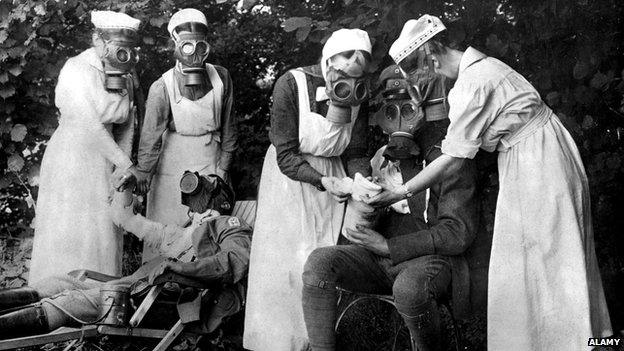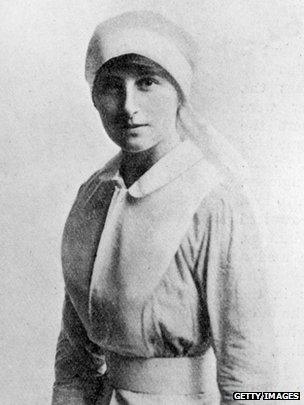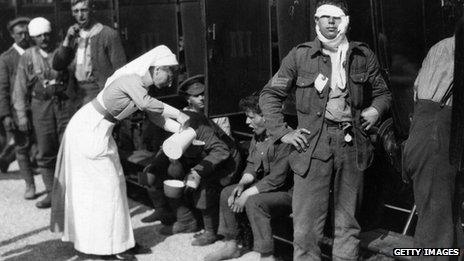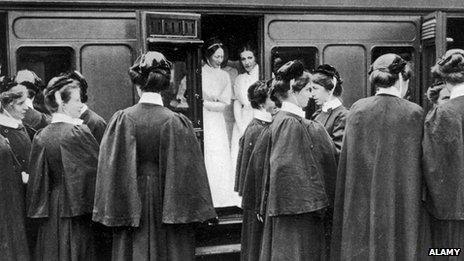World War One: The many battles faced by WW1's nurses
- Published

Nurses and volunteers on both sides faced constant danger
Nursing in World War One was exhausting, often dangerous work and the women who volunteered experienced the horror of war firsthand, some paying the ultimate price. But their story is surrounded by myth and their full contribution often goes unrecognised, writes Shirley Williams.
In his much-admired book published in 1975, The Great War and Modern Memory, the American literary critic and historian, Paul Fussell, wrote about the pervasive myths and legends of WW1, so powerful they became indistinguishable from fact in many minds. Surprisingly, Fussell hardly mentioned nurses. There is no reference to Edith Cavell, let alone Florence Nightingale.
Yet the myth of the gentle young nurse, often a voluntary and untrained VAD (Voluntary Aid Detachment), in her starched and spotless white uniform, was universally admired. It echoed centuries of stories from King Arthur and the Round Table to Shakespeare's Henry V, where rough but brave warriors encountered graceful young women who cared for them.
My mother, Vera Brittain, author of the moving and candid chronicle of her own wartime experience, Testament of Youth, became part of the myth. In the course of the war she lost all the young men she had loved: her fiance Roland, her brother Edward, her dear friends Victor and Geoffrey.
She threw herself into nursing in some of the most dreadful battlegrounds in an attempt to ease the pain of bereavement. She also dedicated herself to recreating the characters and lives of those she had lost so generations of readers would come to know them and they would live in the memory of many. In a way she succeeded, as this short verse in her first published book of poetry, Verses of a VAD (1920), exemplifies:
Epitaph On My Days in Hospital: I found in you a holy place apart, Sublime endurance, God in man revealed, Where mending broken bodies slowly healed, My broken heart
Her personal experience combined with her talent for writing made compelling prose. Because of a few other women writers who had been wartime nurses as well as herself, the legend of the VAD came to dominate nursing history. But despite their accounts, often what was written was neither wholly accurate nor wholly fair. Acceptance of nurses as equal contributors with doctors on the front line is still to fully arrive.
Young men and women in 1914, like their parents, expected the war to be short. Music hall songs were patriotic and optimistic. Women were expected to wait at home patiently or, if they were from working-class homes, to join munitions factories. "Keep the home fires burning," they were abjured. "Though your boys are far away, they will soon come home." Had they been injured, however, there would have been very few nurses to look after them.
The main trained corps of military nurses was the Queen Alexandra's Imperial Military Nursing Service (QAIMNS). It was founded in 1902 at the time of the Boer war and in 1914 was less than 300 strong. At the end of the war four years later it numbered over 10,000 nurses. In addition several other organisations formed earlier in the century had the nursing of members of the armed services as their main purpose - for instance, the First Aid Nursing Yeomanry launched in 1907.

Vera Brittain wanted to honour those lost in WW1
Apart from them there were thousands of untrained women working as midwives or nurses in civilian life, but they had little or no experience of working with soldier patients and their status in society was little better than that of domestic servants.
Because the British Army was so resolutely opposed to all female military nurses except the QAIMNS, early volunteers from Britain were obliged to serve instead with the French and Belgian forces. Many of these early volunteers were from aristocratic families and their servants. Powerful women who ran large families and large estates were well versed in management and saw no great problems in managing a military hospital instead. Their confidence in their own abilities was impressive.
The most famous of these women was the Duchess of Sutherland, nicknamed Meddlesome Millie. Soon after war was declared she and other grand ladies like her took doctors and nurses to France and Belgium, organising their own transport and equipment to set up hospitals and casualty clearing stations.
Whatever bureaucratic obstacles were put in their way, the huge and bloody tide of casualties by the spring of 1915 simply swept them away. Even the British Army's top brass yielded to the combined pressures of need and confident commitment.
At this stage of the war women began to be invited to serve in a range of capacities, of which nursing was one. Thousands of young women from middle-class homes with little experience of domestic work, not much relevant education and total ignorance of male bodies, volunteered and found themselves pitched into military hospitals.
They were not, in most cases, warmly welcomed. Professional nurses, battling for some kind of recognition and for proper training, feared this large invasion of unqualified volunteers would undermine their efforts. Poorly paid VADs were used mainly as domestic labour, cleaning floors, changing bed linen, swilling out bedpans, but were rarely allowed until later in the war to change dressings or administer drugs.
The image and the conspicuous Red Cross uniforms were romantic but the work itself exhausting, unending and sometimes disgusting. Relations between professional nurses and the volunteer assistants were constrained by rigid and unbending discipline. Contracts for VADs could be withdrawn even for slight breaches of the rules.
The climate of hospital life was harsh but many VADs, including my mother, also had to cope with strained relations with their parents and other older relatives. The home front in WW1 was very remote from the fronts where the battles were fought.
There was no television or radio and newspaper reports were much delayed. People learned fragments through long casualty lists or letters from their soldier relatives.
In a letter from her father in the spring of 1918, my mother, at the time looking after soldiers who had been gassed in an understaffed hospital within shelling distance of the German front line, was summoned home. It was "her duty", he wrote, to help her parents cope with the difficulty of running their comfortable home.

There were strict codes of conduct for nurses

Many women had never left home before going to the front
The war produced medical issues largely unknown in civilian life and not previously experienced by doctors or nurses. Most common were wound infections, contracted when men riddled by machine gun bullets had bits of uniform and the polluted mud of the trenches driven into their abdomens and internal organs. There were no antibiotics, of course, and disinfectants were crude and insufficiently supplied.
According to Christine Hallett in her comprehensive and minutely researched book on nursing in WW1, Veiled Warriors, more radical measures were widely used on the Russian front. Wounds were packed with iodide or salt, the body tightly bandaged and the victim shipped for many miles to wartime hospitals.
In Britain much work was done to deal with infected wounds but thousands died of tetanus or gangrene before any effective antidote was discovered. Towards the end of the war, a few radical solutions emerged. One of these was blood transfusion effected simply by linking up a tube between the patient and the donor, a direct transference. A version can be seen at the excellent WW1 exhibition of the Florence Nightingale Museum in the hospital where she herself nursed, St Thomas's in London.
When the war ended, most VADs left the service though a few of the most adventurous went away to other wars. They went home to a world in which men were scarce. It was as much the huge loss of hundreds of thousands of young men in France, Belgium and Great Britain, not to speak of Russia and of course Germany, that advanced the cause of equality and the extension of the suffrage to women.
Lacking men, especially in clerical and commercial fields, employers appointed women and they in turn looked for paid employment and a living wage. But the professions were reluctant to change. Professional nurses, the backbone of the wartime service, failed to get legal recognition of registered status until 1943. Some drifted into public health and midwifery but nursing remained something of a Cinderella service.
Much has improved in the last 60 years, but full acceptance of the knowledge and experience of nurses as equal contributors with doctors to the wellbeing of patients is still a work in progress. Being a largely female profession remains an unjust handicap.
Find out more from Kate Adie about what WW1 did for women and Michael Mosley on the plastic surgery techniques pioneered in WW1.
The poem 'Epitaph on My Days in Hospital' included by permission of Mark Bostridge and T.J. Brittain-Catlin, Literary Executors for the Estate of Vera Brittain, 1970.
Follow @BBCNewsMagazine, external on Twitter and on Facebook, external